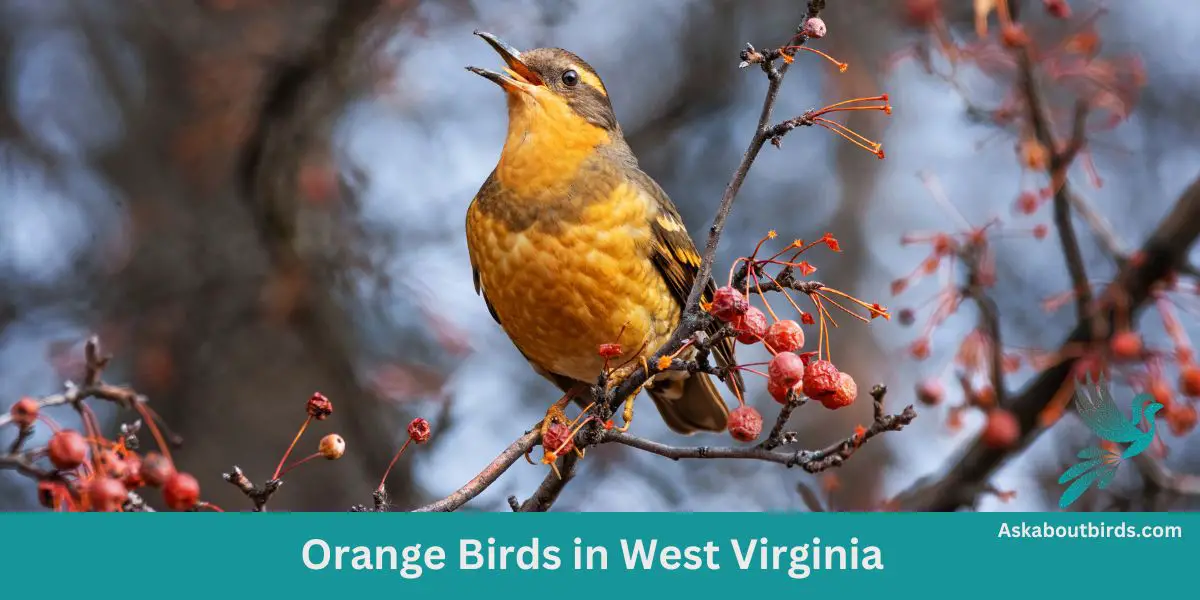Discover the vibrant hues of avian life in the Appalachian heartland. From the melodious calls of the Baltimore Oriole to the swift flash of the Rufous Hummingbird, West Virginia is home to a captivating array of orange-feathered beauties.
Orange Birds Found In West Virginia
West Virginia’s diverse landscape, from its verdant valleys to the elevated peaks of the Appalachians, provides a multitude of habitats for various bird species. The state’s dense forests offer refuge and breeding grounds for migratory and resident birds alike. With changing seasons, the birdlife in West Virginia shifts, promising birdwatchers a unique experience throughout the year.
Baltimore Oriole


| Feature | Measurement |
|---|---|
| Scientific Name | Icterus galbula |
| Length | 6.7–8.7 in |
| Wingspan | 9.1–12.6 in |
| Weight | 22.3-42 g |
The Baltimore Oriole is a stunning bird, best known for its vibrant coloration and its rich, whistling song.
Appearance: The male Baltimore Oriole is notable for his bright orange and black plumage and black and white wing bars, a stark contrast to the more muted yellow-brown coloration of the female. Both sexes, however, have long pointed bills and white bars on their wings.
Diet: Baltimore Orioles have a diverse diet that includes insects, fruits, and nectar. Their preference for sweet juices and fruit pulp often brings them to backyard feeders offering oranges and jelly.
Reproduction: The female Baltimore Oriole is responsible for building the distinctive hanging nest, often woven together from fine materials like hair and grass. These nests are usually high in trees to avoid predators. The female lays 3-7 eggs, which are incubated for about two weeks.
Eastern Towhee

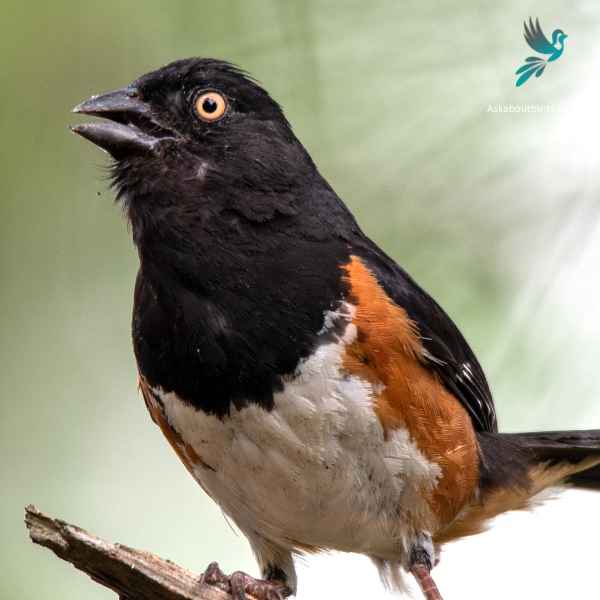
| Feature | Measurement |
|---|---|
| Scientific Name | Pipilo erythrophthalmus |
| Length | 6.8 to 9.1 in |
| Wingspan | 7.9–11.8 in |
| Weight | 32 to 53 g |
The Eastern Towhee is a distinctive songbird known for its unique calls and eye-catching coloration.
Appearance: Male Eastern Towhees are characterized by a striking combination of a black head, back and tail, contrasting with a white belly and rufous flanks. Females sport similar patterns but instead of black, they have a rich brown color. Both genders have red eyes, lending a special charm to their overall appearance.
Diet: Eastern Towhees primarily feed on a variety of insects, seeds, and berries. Their diet is quite diverse, taking advantage of seasonal offerings, which includes beetles, caterpillars, spiders, acorns, grass seeds, and various fruits and berries.
Reproduction: Eastern Towhees build their nests on or near the ground, often in a shrub or a small tree. The female lays around 3-5 eggs and takes the primary role in incubating them over about 12-13 days.
Barn Swallow

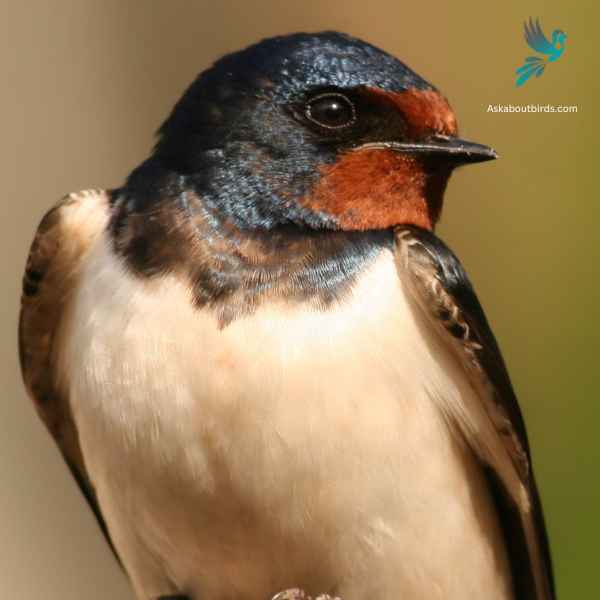
| Feature | Measurement |
|---|---|
| Scientific Name | Hirundo rustica |
| Length | 6.5–7.5 in |
| Wingspan | 12.5–13.5 in |
| Weight | 16–22 g |
The Barn Swallow is a sleek, agile bird renowned for its graceful flight patterns and iconic forked tail, often seen darting over fields and water bodies in search of flying insects.
Appearance: Barn Swallows have deep blue, almost iridescent, upperparts and a rufous to tawny underbelly. Their distinctively forked tail and long wings give them a streamlined look. Both males and females have a similar appearance, though males often exhibit slightly brighter colors and a deeper fork in the tail.
Diet: Barn Swallows feed primarily on flying insects, which they catch in mid-air during their agile and acrobatic flights. Their diet includes flies, beetles, moths, and other small flying insects.
Reproduction: Barn Swallows are known for building their mud nests on man-made structures, particularly barns, bridges, and eaves. The nest is cup-shaped and made from mud pellets, often lined with feathers. The female lays a clutch of 4 to 6 eggs.
American Robins


| Feature | Measurement |
|---|---|
| Scientific Name | Leptotila plumbeicep |
| Length | 10.6-11.8 in |
| Wingspan | — |
| Weight | 160-200 g |
The American Robin is a widely recognized bird species known for its melodious song and early bird tendencies.
Appearance: American Robins are medium-sized birds with a distinctive appearance. Both males and females sport a gray to brown back and a warm red to orange breast and belly and gray wings. They also have a characteristic white eye-ring and a black head, but males are usually darker than females.
Diet: American Robins have a diverse diet that changes depending on the season. In summer, they feed heavily on earthworms, beetles, and other invertebrates, which they catch on the ground. During winter, they mostly eat fruits and berries.
Reproduction: American Robins usually build their nests in trees or shrubs, but they are also known to nest on human-made structures. The female lays a clutch of about 3 to 5 eggs, which she incubates for about 12 to 14 days.
Blackburnian Warbler
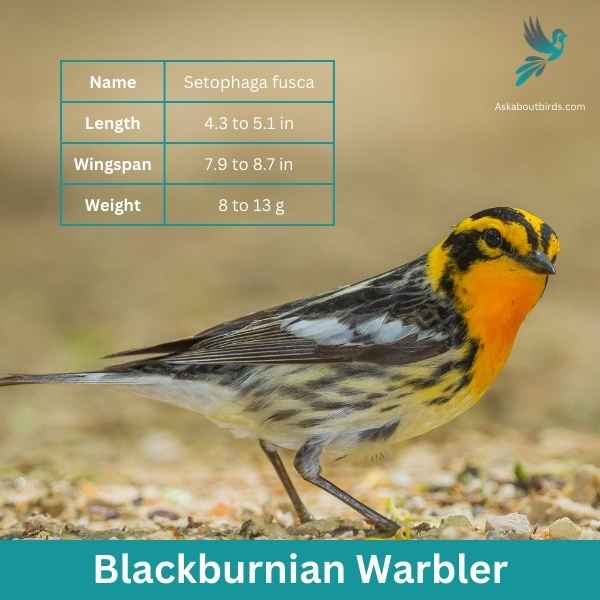

| Feature | Measurement |
|---|---|
| Scientific Name | Setophaga fusca |
| Length | 4.3 to 5.1 in |
| Wingspan | 7.9 to 8.7 in |
| Weight | 8 to 13 g |
The Blackburnian Warbler is a strikingly colored songbird that captivates observers with its vivid plumage, especially during the breeding season. Often found flitting high in the treetops of North American forests, its melodious song is as enchanting as its appearance.
Appearance: Male Blackburnian Warblers are distinguished by their fiery-orange throats, contrasting sharply with a black face, crown, and streaked back. They also have white underparts with black streaks on the sides. Females have a more muted coloration, with a yellowish or pale orange throat and less pronounced streaking.
Diet: Blackburnian Warblers primarily feed on insects and spiders. They are adept at foraging in the canopy, where they glean insects from the surface of leaves and branches or catch them mid-air in quick, agile flights.
Reproduction: Blackburnian Warblers build their nests high up in coniferous trees, often on horizontal branches. The nest is a neat cup made of twigs, grass, and moss, lined with softer materials like hair or feathers. The female lays a clutch of 4 to 5 eggs and takes the lead in incubation.
American Redstart


| Feature | Measurement |
|---|---|
| Scientific Name | Setophaga ruticilla |
| Length | 4.3 to 5.5 in |
| Wingspan | 6.3 to 9.1 in |
| Weight | 8.6 g |
The American Redstart is a lively warbler known for its vivid colors and active hunting style, often seen flitting about, fanning its tail to startle and catch insects.
Appearance: Adult male American Redstarts boast striking black plumage with bright orange patches on the sides, wings, and tail. Females and immature males have grayish-olive upperparts with yellow patches in the same areas where the males display orange.
Diet: American Redstarts are primarily insectivores. They actively forage for flying insects, as well as caterpillars and spiders, often using their colorful tails to startle prey and make them easier to catch.
Reproduction: The female American Redstart builds a cup-shaped nest in the fork of a tree branch. Typically, she lays a clutch of 3 to 5 eggs. The female takes on the primary responsibility of incubating the eggs, while both parents participate in feeding the fledglings after they hatch.
Northern Flicker

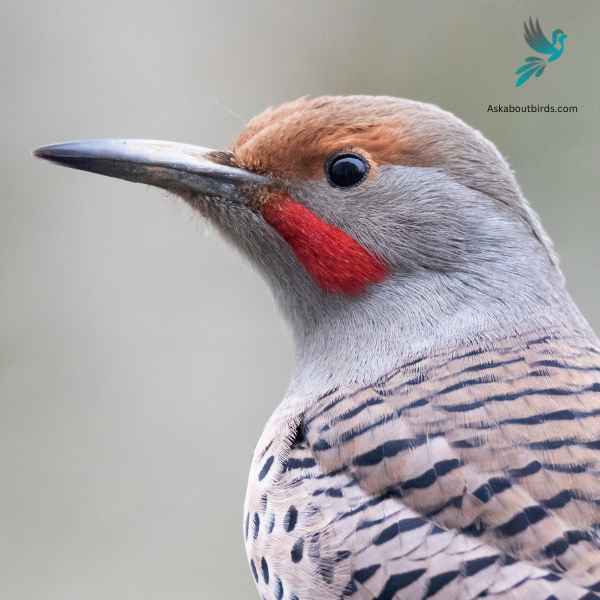
| Feature | Measurement |
|---|---|
| Scientific Name | Colaptes auratus |
| Length | 11–12 in |
| Wingspan | 17–20 in |
| Weight | 3.9–5.6 oz |
The Northern Flicker is a medium-sized woodpecker, recognized by its unique patterns and coloring, often found drumming on trees or foraging on the ground across North America.
Appearance: The Northern Flicker stands out with its grayish brown body, black-scalloped plumage, and a black bib. Males sport a distinctive black or red mustache stripe. Depending on the subspecies, the underwing and undertail feathers can be bright yellow or red, flashing vividly during flight.
Diet: While most woodpeckers are tree-bark foragers, the Northern Flicker prefers hunting on the ground. Its primary diet consists of ants and beetles, supplemented occasionally by fruits, berries, seeds, and other small insects.
Reproduction: Northern Flickers are cavity nesters, preferring to excavate their nesting hole in dead or diseased tree trunks. The interior of the nest is lined with wood chips.
Red-breasted Nuthatch

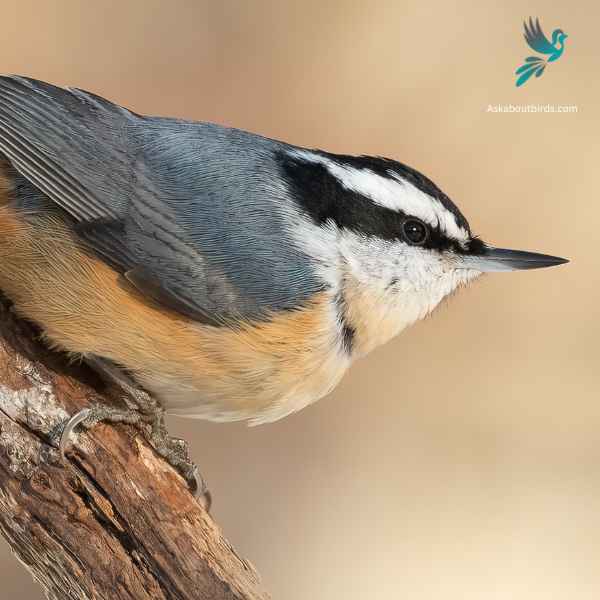
| Feature | Measurement |
|---|---|
| Scientific Name | Sitta canadensis |
| Length | 4.3–4.7 in |
| Wingspan | 8.3 in |
| Weight | 0.3–0.5 oz |
The Red-breasted Nuthatch is a small, agile songbird, known for its ability to move headfirst down tree trunks while searching for food.
Appearance: This bird boasts a slate-blue back and a pale rust-red underside. A prominent black stripe runs through the eye and is bordered above by a white eyebrow. Their sharp, pointed bill is characteristic of the species.
Diet: Red-breasted Nuthatches primarily feed on insects and seeds, especially those from coniferous trees. They have a fondness for large seeds, which they wedge into bark crevices to hack open with their bills.
Reproduction: These birds construct nests in natural tree cavities or abandoned woodpecker holes, often lining the entrance with resin. This is thought to deter predators or competitors from entering. The female typically lays a clutch of 5 to 6 eggs, and both parents partake in feeding the chicks once they hatch.
Orchard Oriole
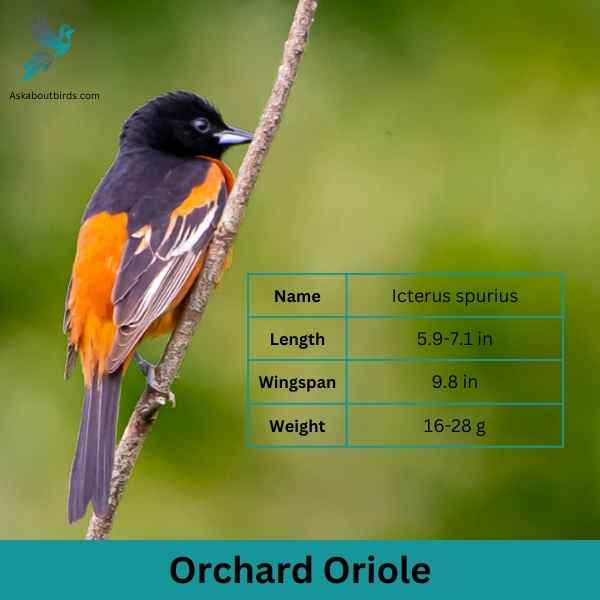
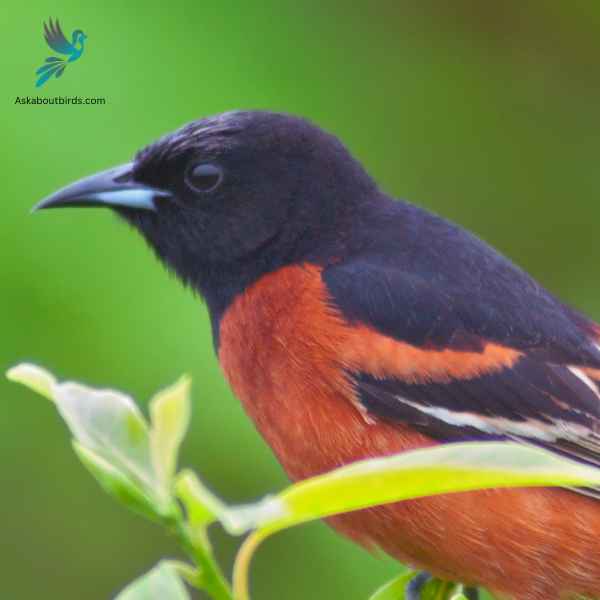
| Feature | Measurement |
|---|---|
| Scientific Name | Icterus spurius |
| Length | 5.9-7.1 in |
| Wingspan | 9.8 in |
| Weight | 16-28 g |
The Orchard Oriole is a small songbird noted for its distinctive coloration and melodic song.
Appearance: Male Orchard Orioles are a striking sight with their dark chestnut body and black head and black and white wings, while females and immature males are olive-green and feature a yellowish underpart. The species is often recognized by its slender body and pointed bill.
Diet: The diet of the Orchard Oriole consists primarily of insects, fruits, and nectar. They are adept at catching insects mid-air and are also known to sip nectar from flowers, aiding in pollination. When fruits are in season, they make up a substantial portion of the bird’s diet.
Reproduction: Orchard Orioles often nest in open woodlands and orchards, hence their name. The female is responsible for building the nest, typically choosing a location in a tree or shrub. The female lays a clutch of 4 to 6 eggs, which she incubates for about two weeks.
Rufous Hummingbird


| Feature | Measurement |
|---|---|
| Scientific Name | Selasphorus rufus |
| Length | 3.1–3.9 in |
| Wingspan | 4.3 in |
| Weight | 0.1–0.2 oz |
The Rufous Hummingbird is a small, brilliantly colored bird known for its impressive migratory journeys and feisty behavior.
Appearance: The male Rufous Hummingbird boasts a gleaming orange-red body with a white chest and an iridescent red throat, called a gorget. The female has green upperparts with rufous-washed flanks and tail. Her throat may have some iridescent patches, but it’s generally whitish.
Diet: Like other hummingbirds, the Rufous Hummingbird primarily feeds on nectar from a variety of flowering plants. They also eat insects and spiders for protein, catching them in flight or plucking them from vegetation.
Reproduction: Rufous Hummingbirds nest in trees, shrubs, or even ferns. The female alone selects the site, builds the nest, and cares for the offspring.
Where to Spot West Virginia’s Orange Birds
West Virginia’s rich topography, encompassing lush forests and rippling waters, is a haven for bird enthusiasts, especially those with an inclination towards vibrant orange birds. Here are some prime locations to observe the state’s feathered wonders:
- New River Gorge National Park and Preserve: This national treasure is not only known for its stunning river views but also for its diverse bird population. From woodland species to those that prefer riparian areas, birdwatchers can spot a myriad of birds, including many with brilliant orange hues.
- Dolly Sods Wilderness: Situated in the Monongahela National Forest, Dolly Sods offers high-altitude plateaus and bogs. This unique ecosystem attracts a variety of bird species, making it a hotspot for birdwatching during migration seasons.
- Canaan Valley National Wildlife Refuge: As the largest inland wetland area in the region, this refuge provides habitats for numerous bird species. Its combination of wetlands, forests, and meadows ensures a diverse bird population throughout the year.
- Beartown State Park: A more secluded gem, this park boasts dense forests and unique rock formations, providing a sanctuary for many woodland bird species. Its serene environment makes it an ideal spot for quiet observation.
- Cranberry Glades Botanical Area: Hosting the largest area of bogs in West Virginia, the acidic wetlands here are perfect for spotting rare bird species, many of which display beautiful orange markings during certain seasons.
| State’s Orange Birds | Top Spots for Orange Birds |
|---|---|
| Kentucky’s Orange Birds | 1. Daniel Boone National Forest 2. Mammoth Cave National Park 3. Red River Gorge Geological Area |
| Ohio’s Orange Birds | 1. Cuyahoga Valley National Park 2. Magee Marsh Wildlife Area 3. Oak Openings Preserve |
| Virginia’s Orange Birds | 1. Shenandoah National Park 2. Great Dismal Swamp National Wildlife Refuge 3. Chincoteague National Wildlife Refuge |
| Pennsylvania’s Orange Birds | 1. Presque Isle State Park 2. Hawk Mountain Sanctuary 3. Pymatuning State Park |
| Maryland’s Orange Birds | 1. Blackwater National Wildlife Refuge 2. Assateague Island National Seashore 3. Catoctin Mountain Park |
FAQs on Orange Bird Species Found in West Virginia
Which birds with orange plumage are commonly found in West Virginia’s forests?
In the forest edges and open woods of West Virginia, the American Robin stands out with its dark gray wings and orange breast. This medium-sized bird is a year-round resident, and during the winter months, they often form flocks, foraging through leaf litter in search of food. Eastern Bluebirds, with their brilliant blue and orange plumage, are another common sight, especially in open woodland areas with isolated trees.
What types of orange birds frequent the bird feeders of Southern West Virginia?
Southern West Virginia sees a flurry of bird activity, especially at bird feeders. American Robins, with their reddish-brown to orange breasts, are frequent visitors. The Eastern Towhee, identifiable by its bright red eyes, black head, and rusty orange sides, also makes an appearance, often scratching at the ground feeders to uncover seeds. For those with hummingbird feeders, the Ruby-throated Hummingbird, characterized by its bright orange throat, can be spotted in the warmer months.
Are there any winter birds in West Virginia with distinctive orange features?
Certainly! The Northern Cardinal, recognizable by its bright red plumage and long tail, stands out against the snowy backdrop of West Virginia’s winters. The males have a deep, bright red hue, while the females sport a more subdued reddish-brown. Both have a distinctive black mask around their eyes. Another winter visitor is the Eastern Towhee, with its dark head, white patch, and rusty orange breast, often found rummaging through leaf litter in search of food.
Which small birds with orange features can be observed in West Virginia’s coniferous forests?
The coniferous forests, especially those with western red cedar trees, are home to several small birds with orange features. The Carolina Wren, distinguished by its bright white eyebrow stripe and warm brown body, is about the size of a sparrow and can often be heard singing its vibrant song from the treetops. Cedar Waxwings, with their sleek appearance and yellow-orange bands on the tail, can also be found, especially when there’s an abundance of fruiting trees.

